Financial Analysis of Sainsbury Plc
VerifiedAdded on 2023/01/19
|15
|3437
|37
AI Summary
This report provides a detailed financial analysis of Sainsbury Plc, including income statements, balance sheets, and financial management techniques used by the company.
Contribute Materials
Your contribution can guide someone’s learning journey. Share your
documents today.

ACF734 ACCOUNTING AND FINANCE
Secure Best Marks with AI Grader
Need help grading? Try our AI Grader for instant feedback on your assignments.
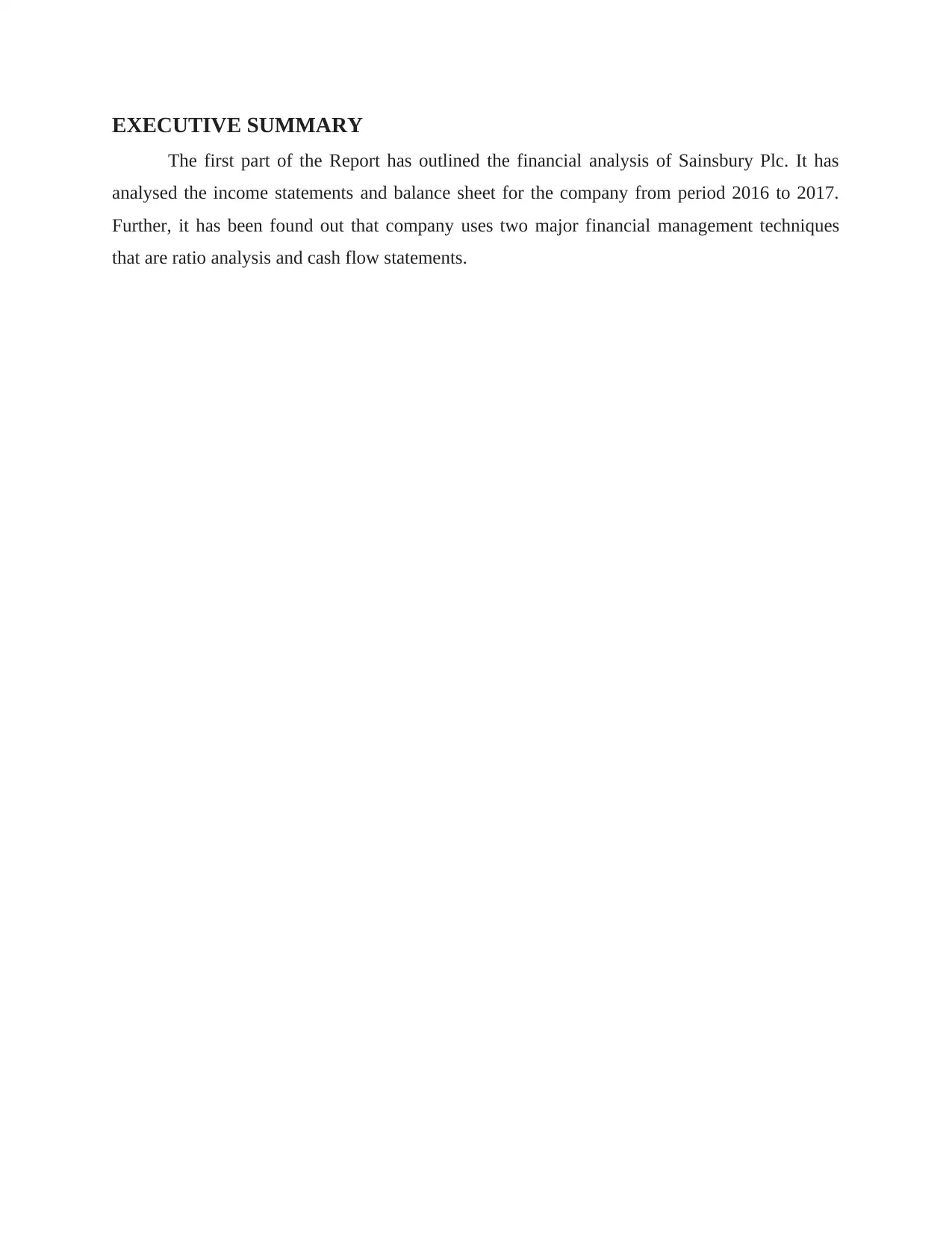
EXECUTIVE SUMMARY
The first part of the Report has outlined the financial analysis of Sainsbury Plc. It has
analysed the income statements and balance sheet for the company from period 2016 to 2017.
Further, it has been found out that company uses two major financial management techniques
that are ratio analysis and cash flow statements.
The first part of the Report has outlined the financial analysis of Sainsbury Plc. It has
analysed the income statements and balance sheet for the company from period 2016 to 2017.
Further, it has been found out that company uses two major financial management techniques
that are ratio analysis and cash flow statements.
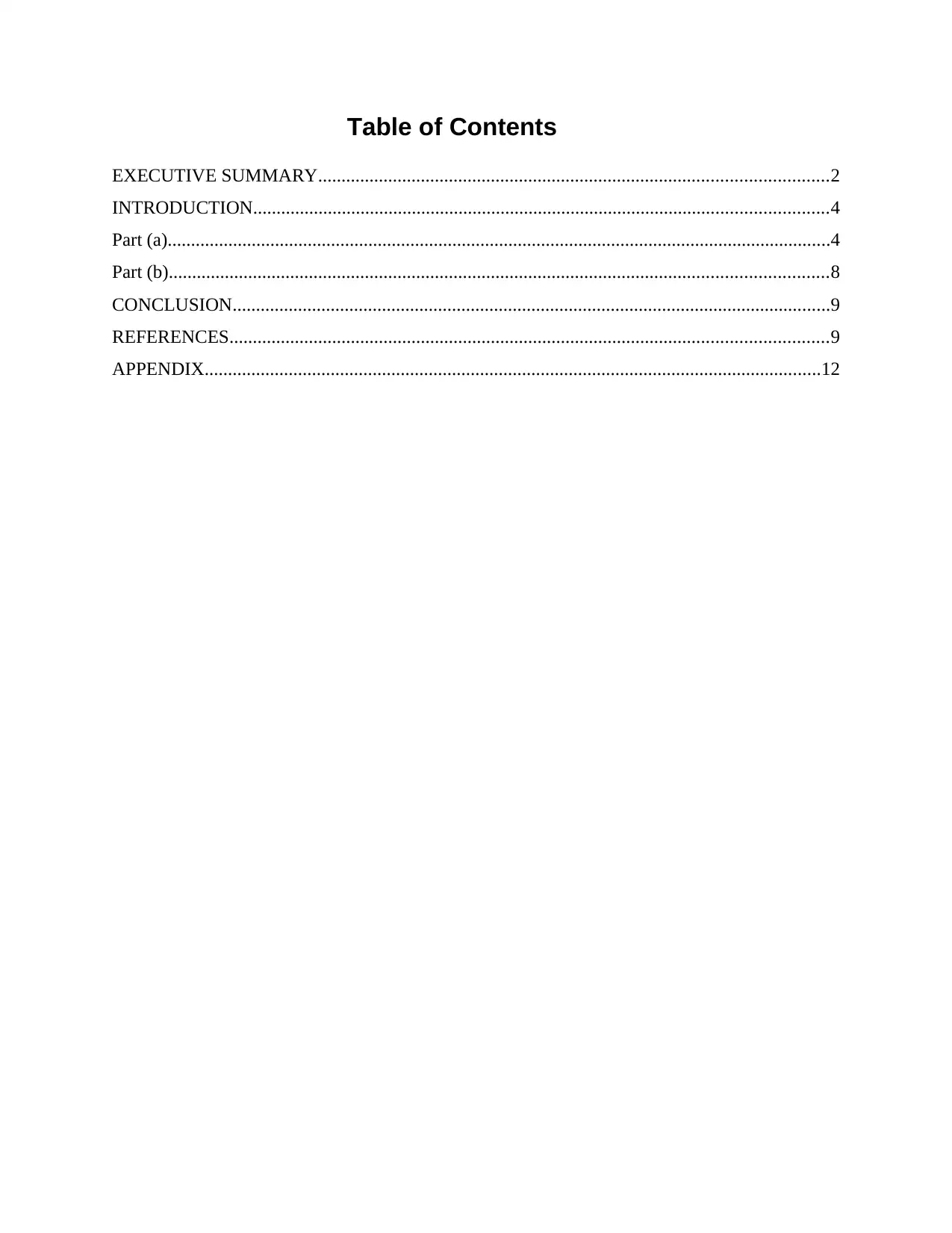
Table of Contents
EXECUTIVE SUMMARY.............................................................................................................2
INTRODUCTION...........................................................................................................................4
Part (a)..............................................................................................................................................4
Part (b).............................................................................................................................................8
CONCLUSION................................................................................................................................9
REFERENCES................................................................................................................................9
APPENDIX....................................................................................................................................12
EXECUTIVE SUMMARY.............................................................................................................2
INTRODUCTION...........................................................................................................................4
Part (a)..............................................................................................................................................4
Part (b).............................................................................................................................................8
CONCLUSION................................................................................................................................9
REFERENCES................................................................................................................................9
APPENDIX....................................................................................................................................12
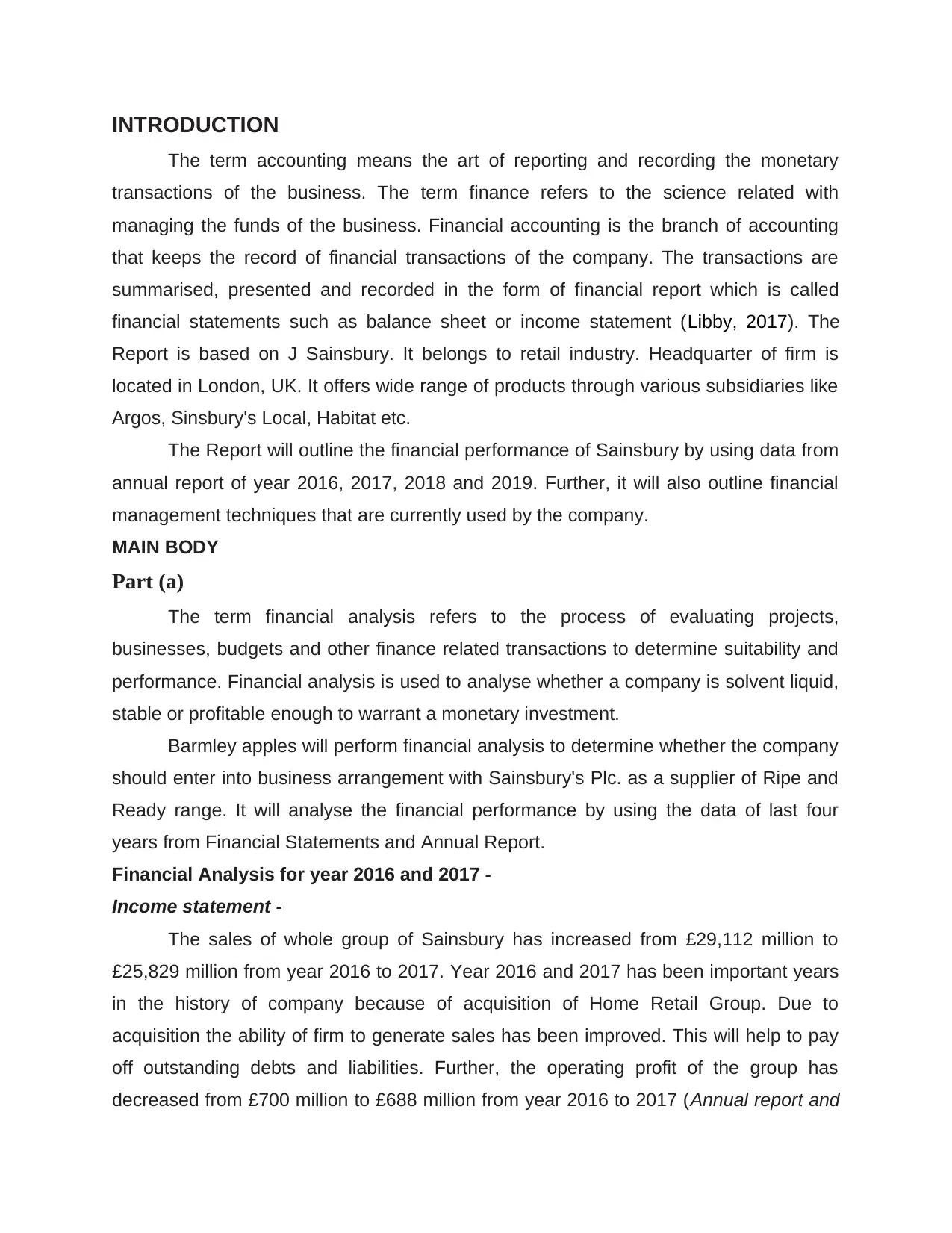
INTRODUCTION
The term accounting means the art of reporting and recording the monetary
transactions of the business. The term finance refers to the science related with
managing the funds of the business. Financial accounting is the branch of accounting
that keeps the record of financial transactions of the company. The transactions are
summarised, presented and recorded in the form of financial report which is called
financial statements such as balance sheet or income statement (Libby, 2017). The
Report is based on J Sainsbury. It belongs to retail industry. Headquarter of firm is
located in London, UK. It offers wide range of products through various subsidiaries like
Argos, Sinsbury's Local, Habitat etc.
The Report will outline the financial performance of Sainsbury by using data from
annual report of year 2016, 2017, 2018 and 2019. Further, it will also outline financial
management techniques that are currently used by the company.
MAIN BODY
Part (a)
The term financial analysis refers to the process of evaluating projects,
businesses, budgets and other finance related transactions to determine suitability and
performance. Financial analysis is used to analyse whether a company is solvent liquid,
stable or profitable enough to warrant a monetary investment.
Barmley apples will perform financial analysis to determine whether the company
should enter into business arrangement with Sainsbury's Plc. as a supplier of Ripe and
Ready range. It will analyse the financial performance by using the data of last four
years from Financial Statements and Annual Report.
Financial Analysis for year 2016 and 2017 -
Income statement -
The sales of whole group of Sainsbury has increased from £29,112 million to
£25,829 million from year 2016 to 2017. Year 2016 and 2017 has been important years
in the history of company because of acquisition of Home Retail Group. Due to
acquisition the ability of firm to generate sales has been improved. This will help to pay
off outstanding debts and liabilities. Further, the operating profit of the group has
decreased from £700 million to £688 million from year 2016 to 2017 (Annual report and
The term accounting means the art of reporting and recording the monetary
transactions of the business. The term finance refers to the science related with
managing the funds of the business. Financial accounting is the branch of accounting
that keeps the record of financial transactions of the company. The transactions are
summarised, presented and recorded in the form of financial report which is called
financial statements such as balance sheet or income statement (Libby, 2017). The
Report is based on J Sainsbury. It belongs to retail industry. Headquarter of firm is
located in London, UK. It offers wide range of products through various subsidiaries like
Argos, Sinsbury's Local, Habitat etc.
The Report will outline the financial performance of Sainsbury by using data from
annual report of year 2016, 2017, 2018 and 2019. Further, it will also outline financial
management techniques that are currently used by the company.
MAIN BODY
Part (a)
The term financial analysis refers to the process of evaluating projects,
businesses, budgets and other finance related transactions to determine suitability and
performance. Financial analysis is used to analyse whether a company is solvent liquid,
stable or profitable enough to warrant a monetary investment.
Barmley apples will perform financial analysis to determine whether the company
should enter into business arrangement with Sainsbury's Plc. as a supplier of Ripe and
Ready range. It will analyse the financial performance by using the data of last four
years from Financial Statements and Annual Report.
Financial Analysis for year 2016 and 2017 -
Income statement -
The sales of whole group of Sainsbury has increased from £29,112 million to
£25,829 million from year 2016 to 2017. Year 2016 and 2017 has been important years
in the history of company because of acquisition of Home Retail Group. Due to
acquisition the ability of firm to generate sales has been improved. This will help to pay
off outstanding debts and liabilities. Further, the operating profit of the group has
decreased from £700 million to £688 million from year 2016 to 2017 (Annual report and
Secure Best Marks with AI Grader
Need help grading? Try our AI Grader for instant feedback on your assignments.
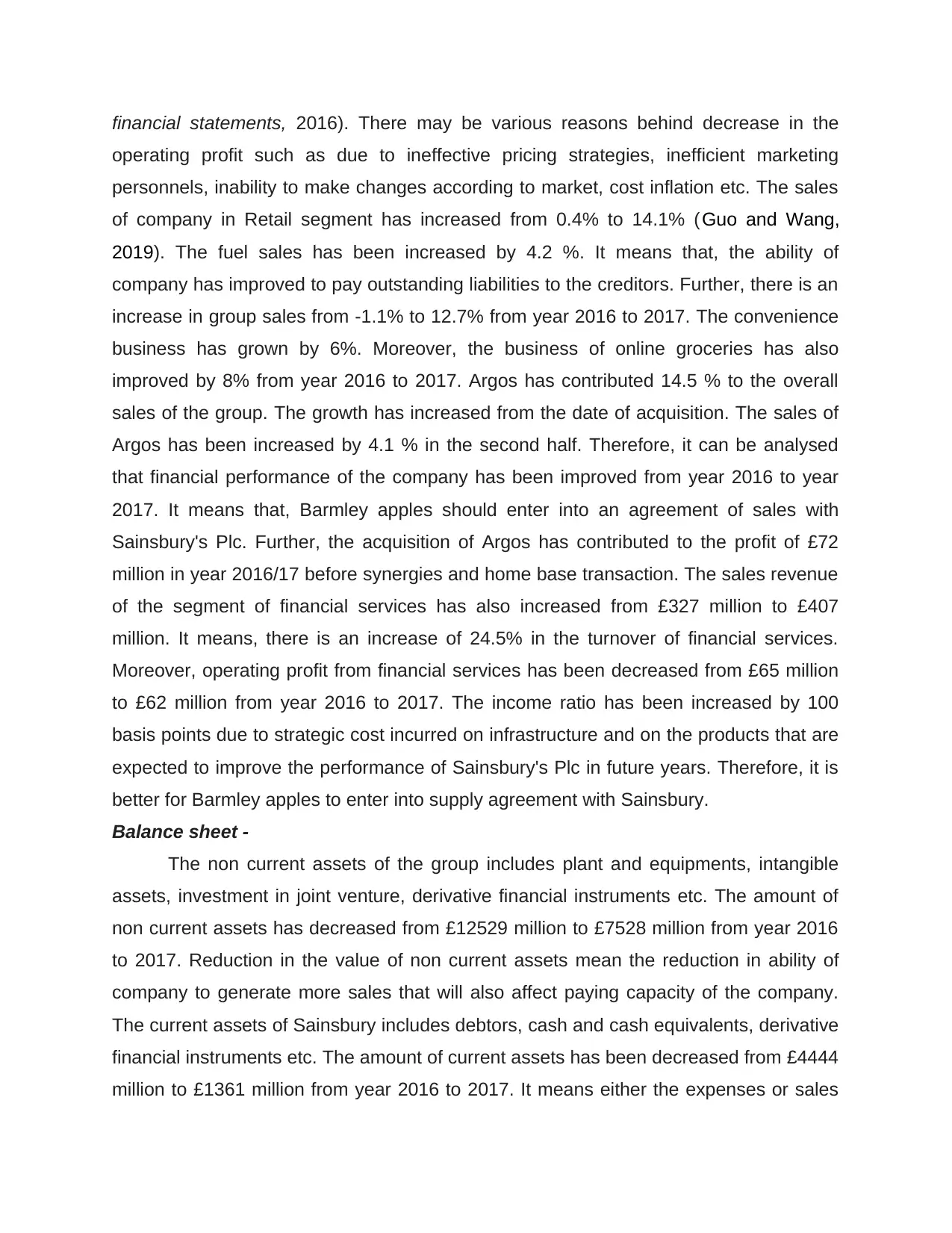
financial statements, 2016). There may be various reasons behind decrease in the
operating profit such as due to ineffective pricing strategies, inefficient marketing
personnels, inability to make changes according to market, cost inflation etc. The sales
of company in Retail segment has increased from 0.4% to 14.1% (Guo and Wang,
2019). The fuel sales has been increased by 4.2 %. It means that, the ability of
company has improved to pay outstanding liabilities to the creditors. Further, there is an
increase in group sales from -1.1% to 12.7% from year 2016 to 2017. The convenience
business has grown by 6%. Moreover, the business of online groceries has also
improved by 8% from year 2016 to 2017. Argos has contributed 14.5 % to the overall
sales of the group. The growth has increased from the date of acquisition. The sales of
Argos has been increased by 4.1 % in the second half. Therefore, it can be analysed
that financial performance of the company has been improved from year 2016 to year
2017. It means that, Barmley apples should enter into an agreement of sales with
Sainsbury's Plc. Further, the acquisition of Argos has contributed to the profit of £72
million in year 2016/17 before synergies and home base transaction. The sales revenue
of the segment of financial services has also increased from £327 million to £407
million. It means, there is an increase of 24.5% in the turnover of financial services.
Moreover, operating profit from financial services has been decreased from £65 million
to £62 million from year 2016 to 2017. The income ratio has been increased by 100
basis points due to strategic cost incurred on infrastructure and on the products that are
expected to improve the performance of Sainsbury's Plc in future years. Therefore, it is
better for Barmley apples to enter into supply agreement with Sainsbury.
Balance sheet -
The non current assets of the group includes plant and equipments, intangible
assets, investment in joint venture, derivative financial instruments etc. The amount of
non current assets has decreased from £12529 million to £7528 million from year 2016
to 2017. Reduction in the value of non current assets mean the reduction in ability of
company to generate more sales that will also affect paying capacity of the company.
The current assets of Sainsbury includes debtors, cash and cash equivalents, derivative
financial instruments etc. The amount of current assets has been decreased from £4444
million to £1361 million from year 2016 to 2017. It means either the expenses or sales
operating profit such as due to ineffective pricing strategies, inefficient marketing
personnels, inability to make changes according to market, cost inflation etc. The sales
of company in Retail segment has increased from 0.4% to 14.1% (Guo and Wang,
2019). The fuel sales has been increased by 4.2 %. It means that, the ability of
company has improved to pay outstanding liabilities to the creditors. Further, there is an
increase in group sales from -1.1% to 12.7% from year 2016 to 2017. The convenience
business has grown by 6%. Moreover, the business of online groceries has also
improved by 8% from year 2016 to 2017. Argos has contributed 14.5 % to the overall
sales of the group. The growth has increased from the date of acquisition. The sales of
Argos has been increased by 4.1 % in the second half. Therefore, it can be analysed
that financial performance of the company has been improved from year 2016 to year
2017. It means that, Barmley apples should enter into an agreement of sales with
Sainsbury's Plc. Further, the acquisition of Argos has contributed to the profit of £72
million in year 2016/17 before synergies and home base transaction. The sales revenue
of the segment of financial services has also increased from £327 million to £407
million. It means, there is an increase of 24.5% in the turnover of financial services.
Moreover, operating profit from financial services has been decreased from £65 million
to £62 million from year 2016 to 2017. The income ratio has been increased by 100
basis points due to strategic cost incurred on infrastructure and on the products that are
expected to improve the performance of Sainsbury's Plc in future years. Therefore, it is
better for Barmley apples to enter into supply agreement with Sainsbury.
Balance sheet -
The non current assets of the group includes plant and equipments, intangible
assets, investment in joint venture, derivative financial instruments etc. The amount of
non current assets has decreased from £12529 million to £7528 million from year 2016
to 2017. Reduction in the value of non current assets mean the reduction in ability of
company to generate more sales that will also affect paying capacity of the company.
The current assets of Sainsbury includes debtors, cash and cash equivalents, derivative
financial instruments etc. The amount of current assets has been decreased from £4444
million to £1361 million from year 2016 to 2017. It means either the expenses or sales
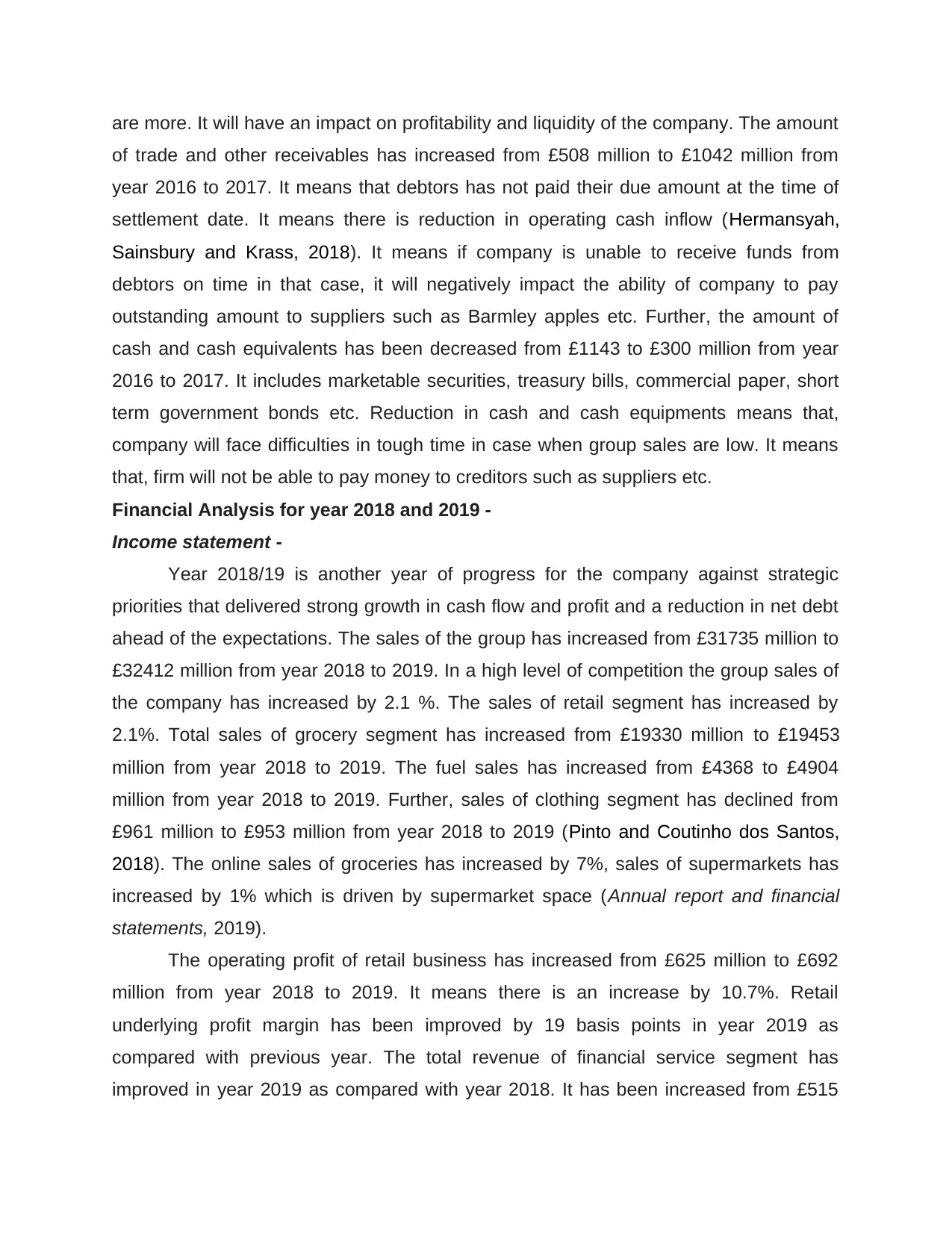
are more. It will have an impact on profitability and liquidity of the company. The amount
of trade and other receivables has increased from £508 million to £1042 million from
year 2016 to 2017. It means that debtors has not paid their due amount at the time of
settlement date. It means there is reduction in operating cash inflow (Hermansyah,
Sainsbury and Krass, 2018). It means if company is unable to receive funds from
debtors on time in that case, it will negatively impact the ability of company to pay
outstanding amount to suppliers such as Barmley apples etc. Further, the amount of
cash and cash equivalents has been decreased from £1143 to £300 million from year
2016 to 2017. It includes marketable securities, treasury bills, commercial paper, short
term government bonds etc. Reduction in cash and cash equipments means that,
company will face difficulties in tough time in case when group sales are low. It means
that, firm will not be able to pay money to creditors such as suppliers etc.
Financial Analysis for year 2018 and 2019 -
Income statement -
Year 2018/19 is another year of progress for the company against strategic
priorities that delivered strong growth in cash flow and profit and a reduction in net debt
ahead of the expectations. The sales of the group has increased from £31735 million to
£32412 million from year 2018 to 2019. In a high level of competition the group sales of
the company has increased by 2.1 %. The sales of retail segment has increased by
2.1%. Total sales of grocery segment has increased from £19330 million to £19453
million from year 2018 to 2019. The fuel sales has increased from £4368 to £4904
million from year 2018 to 2019. Further, sales of clothing segment has declined from
£961 million to £953 million from year 2018 to 2019 (Pinto and Coutinho dos Santos,
2018). The online sales of groceries has increased by 7%, sales of supermarkets has
increased by 1% which is driven by supermarket space (Annual report and financial
statements, 2019).
The operating profit of retail business has increased from £625 million to £692
million from year 2018 to 2019. It means there is an increase by 10.7%. Retail
underlying profit margin has been improved by 19 basis points in year 2019 as
compared with previous year. The total revenue of financial service segment has
improved in year 2019 as compared with year 2018. It has been increased from £515
of trade and other receivables has increased from £508 million to £1042 million from
year 2016 to 2017. It means that debtors has not paid their due amount at the time of
settlement date. It means there is reduction in operating cash inflow (Hermansyah,
Sainsbury and Krass, 2018). It means if company is unable to receive funds from
debtors on time in that case, it will negatively impact the ability of company to pay
outstanding amount to suppliers such as Barmley apples etc. Further, the amount of
cash and cash equivalents has been decreased from £1143 to £300 million from year
2016 to 2017. It includes marketable securities, treasury bills, commercial paper, short
term government bonds etc. Reduction in cash and cash equipments means that,
company will face difficulties in tough time in case when group sales are low. It means
that, firm will not be able to pay money to creditors such as suppliers etc.
Financial Analysis for year 2018 and 2019 -
Income statement -
Year 2018/19 is another year of progress for the company against strategic
priorities that delivered strong growth in cash flow and profit and a reduction in net debt
ahead of the expectations. The sales of the group has increased from £31735 million to
£32412 million from year 2018 to 2019. In a high level of competition the group sales of
the company has increased by 2.1 %. The sales of retail segment has increased by
2.1%. Total sales of grocery segment has increased from £19330 million to £19453
million from year 2018 to 2019. The fuel sales has increased from £4368 to £4904
million from year 2018 to 2019. Further, sales of clothing segment has declined from
£961 million to £953 million from year 2018 to 2019 (Pinto and Coutinho dos Santos,
2018). The online sales of groceries has increased by 7%, sales of supermarkets has
increased by 1% which is driven by supermarket space (Annual report and financial
statements, 2019).
The operating profit of retail business has increased from £625 million to £692
million from year 2018 to 2019. It means there is an increase by 10.7%. Retail
underlying profit margin has been improved by 19 basis points in year 2019 as
compared with previous year. The total revenue of financial service segment has
improved in year 2019 as compared with year 2018. It has been increased from £515
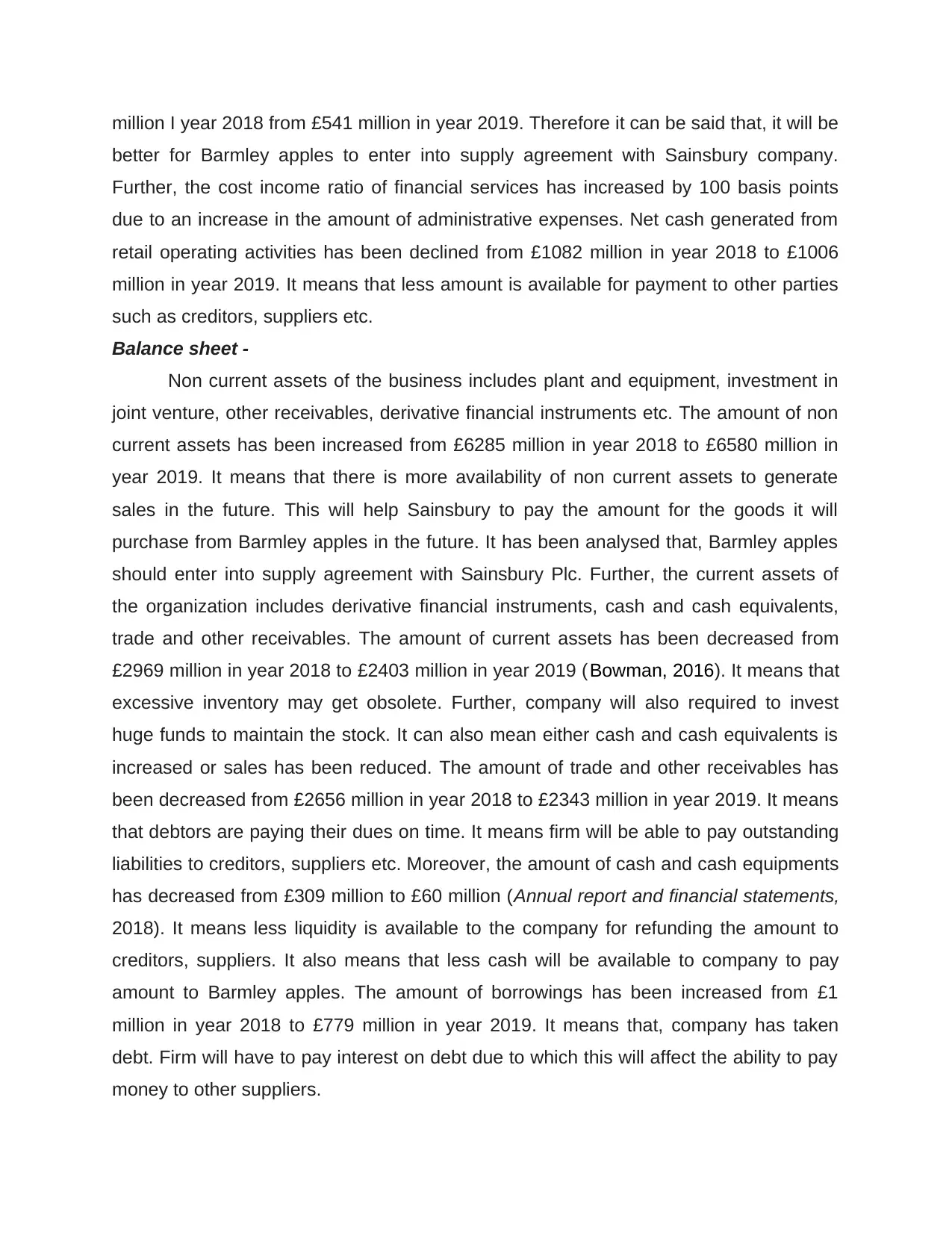
million I year 2018 from £541 million in year 2019. Therefore it can be said that, it will be
better for Barmley apples to enter into supply agreement with Sainsbury company.
Further, the cost income ratio of financial services has increased by 100 basis points
due to an increase in the amount of administrative expenses. Net cash generated from
retail operating activities has been declined from £1082 million in year 2018 to £1006
million in year 2019. It means that less amount is available for payment to other parties
such as creditors, suppliers etc.
Balance sheet -
Non current assets of the business includes plant and equipment, investment in
joint venture, other receivables, derivative financial instruments etc. The amount of non
current assets has been increased from £6285 million in year 2018 to £6580 million in
year 2019. It means that there is more availability of non current assets to generate
sales in the future. This will help Sainsbury to pay the amount for the goods it will
purchase from Barmley apples in the future. It has been analysed that, Barmley apples
should enter into supply agreement with Sainsbury Plc. Further, the current assets of
the organization includes derivative financial instruments, cash and cash equivalents,
trade and other receivables. The amount of current assets has been decreased from
£2969 million in year 2018 to £2403 million in year 2019 (Bowman, 2016). It means that
excessive inventory may get obsolete. Further, company will also required to invest
huge funds to maintain the stock. It can also mean either cash and cash equivalents is
increased or sales has been reduced. The amount of trade and other receivables has
been decreased from £2656 million in year 2018 to £2343 million in year 2019. It means
that debtors are paying their dues on time. It means firm will be able to pay outstanding
liabilities to creditors, suppliers etc. Moreover, the amount of cash and cash equipments
has decreased from £309 million to £60 million (Annual report and financial statements,
2018). It means less liquidity is available to the company for refunding the amount to
creditors, suppliers. It also means that less cash will be available to company to pay
amount to Barmley apples. The amount of borrowings has been increased from £1
million in year 2018 to £779 million in year 2019. It means that, company has taken
debt. Firm will have to pay interest on debt due to which this will affect the ability to pay
money to other suppliers.
better for Barmley apples to enter into supply agreement with Sainsbury company.
Further, the cost income ratio of financial services has increased by 100 basis points
due to an increase in the amount of administrative expenses. Net cash generated from
retail operating activities has been declined from £1082 million in year 2018 to £1006
million in year 2019. It means that less amount is available for payment to other parties
such as creditors, suppliers etc.
Balance sheet -
Non current assets of the business includes plant and equipment, investment in
joint venture, other receivables, derivative financial instruments etc. The amount of non
current assets has been increased from £6285 million in year 2018 to £6580 million in
year 2019. It means that there is more availability of non current assets to generate
sales in the future. This will help Sainsbury to pay the amount for the goods it will
purchase from Barmley apples in the future. It has been analysed that, Barmley apples
should enter into supply agreement with Sainsbury Plc. Further, the current assets of
the organization includes derivative financial instruments, cash and cash equivalents,
trade and other receivables. The amount of current assets has been decreased from
£2969 million in year 2018 to £2403 million in year 2019 (Bowman, 2016). It means that
excessive inventory may get obsolete. Further, company will also required to invest
huge funds to maintain the stock. It can also mean either cash and cash equivalents is
increased or sales has been reduced. The amount of trade and other receivables has
been decreased from £2656 million in year 2018 to £2343 million in year 2019. It means
that debtors are paying their dues on time. It means firm will be able to pay outstanding
liabilities to creditors, suppliers etc. Moreover, the amount of cash and cash equipments
has decreased from £309 million to £60 million (Annual report and financial statements,
2018). It means less liquidity is available to the company for refunding the amount to
creditors, suppliers. It also means that less cash will be available to company to pay
amount to Barmley apples. The amount of borrowings has been increased from £1
million in year 2018 to £779 million in year 2019. It means that, company has taken
debt. Firm will have to pay interest on debt due to which this will affect the ability to pay
money to other suppliers.
Paraphrase This Document
Need a fresh take? Get an instant paraphrase of this document with our AI Paraphraser
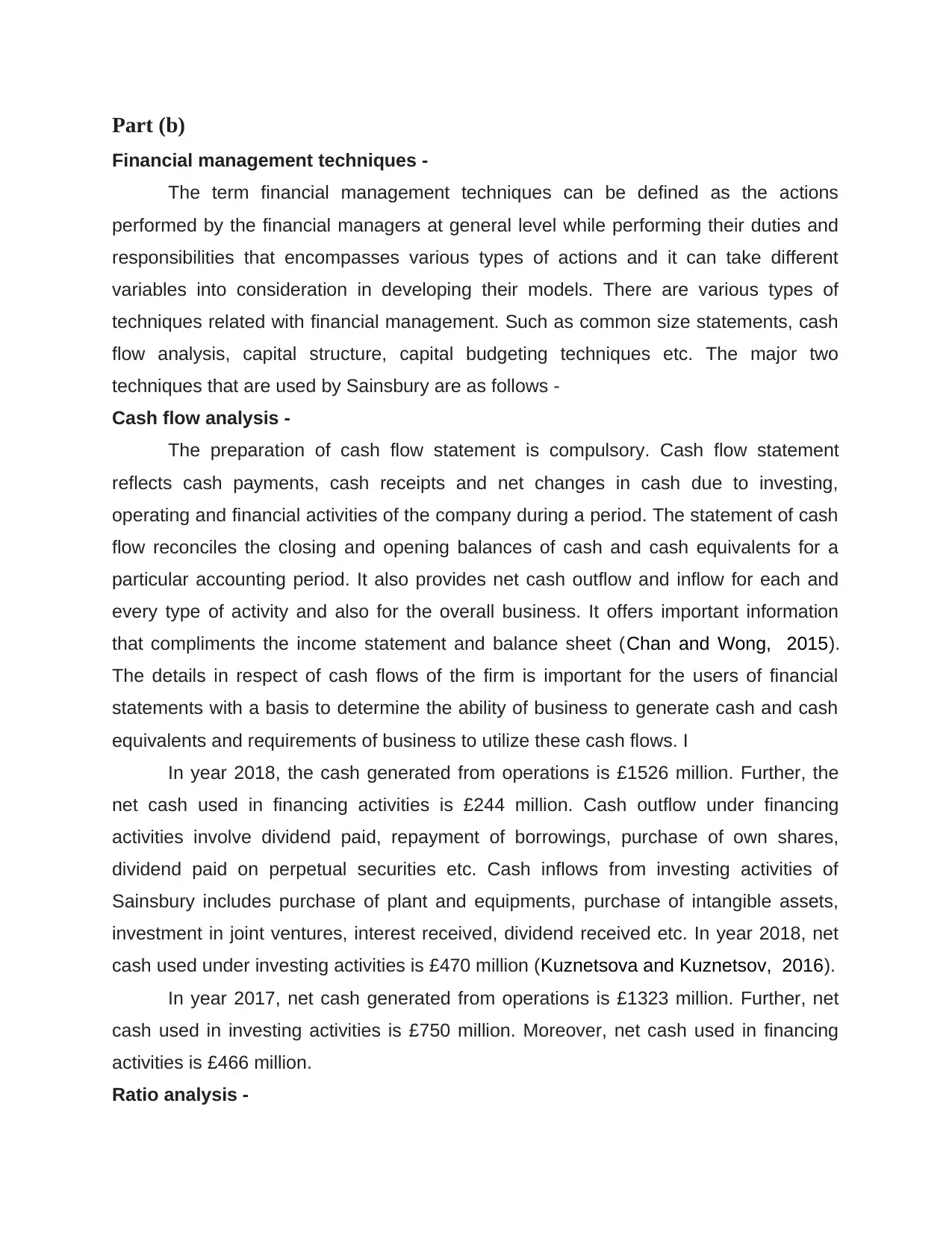
Part (b)
Financial management techniques -
The term financial management techniques can be defined as the actions
performed by the financial managers at general level while performing their duties and
responsibilities that encompasses various types of actions and it can take different
variables into consideration in developing their models. There are various types of
techniques related with financial management. Such as common size statements, cash
flow analysis, capital structure, capital budgeting techniques etc. The major two
techniques that are used by Sainsbury are as follows -
Cash flow analysis -
The preparation of cash flow statement is compulsory. Cash flow statement
reflects cash payments, cash receipts and net changes in cash due to investing,
operating and financial activities of the company during a period. The statement of cash
flow reconciles the closing and opening balances of cash and cash equivalents for a
particular accounting period. It also provides net cash outflow and inflow for each and
every type of activity and also for the overall business. It offers important information
that compliments the income statement and balance sheet (Chan and Wong, 2015).
The details in respect of cash flows of the firm is important for the users of financial
statements with a basis to determine the ability of business to generate cash and cash
equivalents and requirements of business to utilize these cash flows. I
In year 2018, the cash generated from operations is £1526 million. Further, the
net cash used in financing activities is £244 million. Cash outflow under financing
activities involve dividend paid, repayment of borrowings, purchase of own shares,
dividend paid on perpetual securities etc. Cash inflows from investing activities of
Sainsbury includes purchase of plant and equipments, purchase of intangible assets,
investment in joint ventures, interest received, dividend received etc. In year 2018, net
cash used under investing activities is £470 million (Kuznetsova and Kuznetsov, 2016).
In year 2017, net cash generated from operations is £1323 million. Further, net
cash used in investing activities is £750 million. Moreover, net cash used in financing
activities is £466 million.
Ratio analysis -
Financial management techniques -
The term financial management techniques can be defined as the actions
performed by the financial managers at general level while performing their duties and
responsibilities that encompasses various types of actions and it can take different
variables into consideration in developing their models. There are various types of
techniques related with financial management. Such as common size statements, cash
flow analysis, capital structure, capital budgeting techniques etc. The major two
techniques that are used by Sainsbury are as follows -
Cash flow analysis -
The preparation of cash flow statement is compulsory. Cash flow statement
reflects cash payments, cash receipts and net changes in cash due to investing,
operating and financial activities of the company during a period. The statement of cash
flow reconciles the closing and opening balances of cash and cash equivalents for a
particular accounting period. It also provides net cash outflow and inflow for each and
every type of activity and also for the overall business. It offers important information
that compliments the income statement and balance sheet (Chan and Wong, 2015).
The details in respect of cash flows of the firm is important for the users of financial
statements with a basis to determine the ability of business to generate cash and cash
equivalents and requirements of business to utilize these cash flows. I
In year 2018, the cash generated from operations is £1526 million. Further, the
net cash used in financing activities is £244 million. Cash outflow under financing
activities involve dividend paid, repayment of borrowings, purchase of own shares,
dividend paid on perpetual securities etc. Cash inflows from investing activities of
Sainsbury includes purchase of plant and equipments, purchase of intangible assets,
investment in joint ventures, interest received, dividend received etc. In year 2018, net
cash used under investing activities is £470 million (Kuznetsova and Kuznetsov, 2016).
In year 2017, net cash generated from operations is £1323 million. Further, net
cash used in investing activities is £750 million. Moreover, net cash used in financing
activities is £466 million.
Ratio analysis -
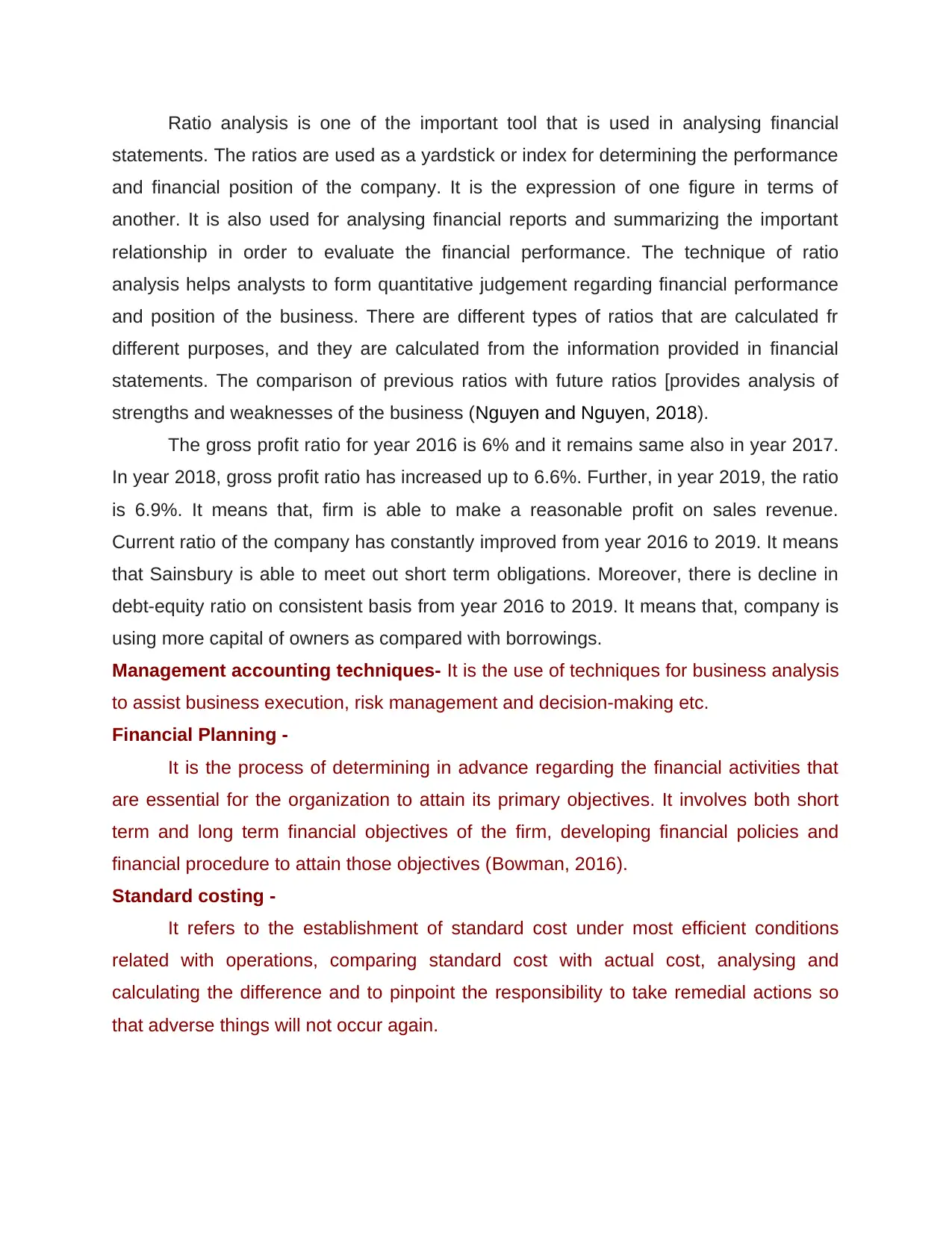
Ratio analysis is one of the important tool that is used in analysing financial
statements. The ratios are used as a yardstick or index for determining the performance
and financial position of the company. It is the expression of one figure in terms of
another. It is also used for analysing financial reports and summarizing the important
relationship in order to evaluate the financial performance. The technique of ratio
analysis helps analysts to form quantitative judgement regarding financial performance
and position of the business. There are different types of ratios that are calculated fr
different purposes, and they are calculated from the information provided in financial
statements. The comparison of previous ratios with future ratios [provides analysis of
strengths and weaknesses of the business (Nguyen and Nguyen, 2018).
The gross profit ratio for year 2016 is 6% and it remains same also in year 2017.
In year 2018, gross profit ratio has increased up to 6.6%. Further, in year 2019, the ratio
is 6.9%. It means that, firm is able to make a reasonable profit on sales revenue.
Current ratio of the company has constantly improved from year 2016 to 2019. It means
that Sainsbury is able to meet out short term obligations. Moreover, there is decline in
debt-equity ratio on consistent basis from year 2016 to 2019. It means that, company is
using more capital of owners as compared with borrowings.
Management accounting techniques- It is the use of techniques for business analysis
to assist business execution, risk management and decision-making etc.
Financial Planning -
It is the process of determining in advance regarding the financial activities that
are essential for the organization to attain its primary objectives. It involves both short
term and long term financial objectives of the firm, developing financial policies and
financial procedure to attain those objectives (Bowman, 2016).
Standard costing -
It refers to the establishment of standard cost under most efficient conditions
related with operations, comparing standard cost with actual cost, analysing and
calculating the difference and to pinpoint the responsibility to take remedial actions so
that adverse things will not occur again.
statements. The ratios are used as a yardstick or index for determining the performance
and financial position of the company. It is the expression of one figure in terms of
another. It is also used for analysing financial reports and summarizing the important
relationship in order to evaluate the financial performance. The technique of ratio
analysis helps analysts to form quantitative judgement regarding financial performance
and position of the business. There are different types of ratios that are calculated fr
different purposes, and they are calculated from the information provided in financial
statements. The comparison of previous ratios with future ratios [provides analysis of
strengths and weaknesses of the business (Nguyen and Nguyen, 2018).
The gross profit ratio for year 2016 is 6% and it remains same also in year 2017.
In year 2018, gross profit ratio has increased up to 6.6%. Further, in year 2019, the ratio
is 6.9%. It means that, firm is able to make a reasonable profit on sales revenue.
Current ratio of the company has constantly improved from year 2016 to 2019. It means
that Sainsbury is able to meet out short term obligations. Moreover, there is decline in
debt-equity ratio on consistent basis from year 2016 to 2019. It means that, company is
using more capital of owners as compared with borrowings.
Management accounting techniques- It is the use of techniques for business analysis
to assist business execution, risk management and decision-making etc.
Financial Planning -
It is the process of determining in advance regarding the financial activities that
are essential for the organization to attain its primary objectives. It involves both short
term and long term financial objectives of the firm, developing financial policies and
financial procedure to attain those objectives (Bowman, 2016).
Standard costing -
It refers to the establishment of standard cost under most efficient conditions
related with operations, comparing standard cost with actual cost, analysing and
calculating the difference and to pinpoint the responsibility to take remedial actions so
that adverse things will not occur again.
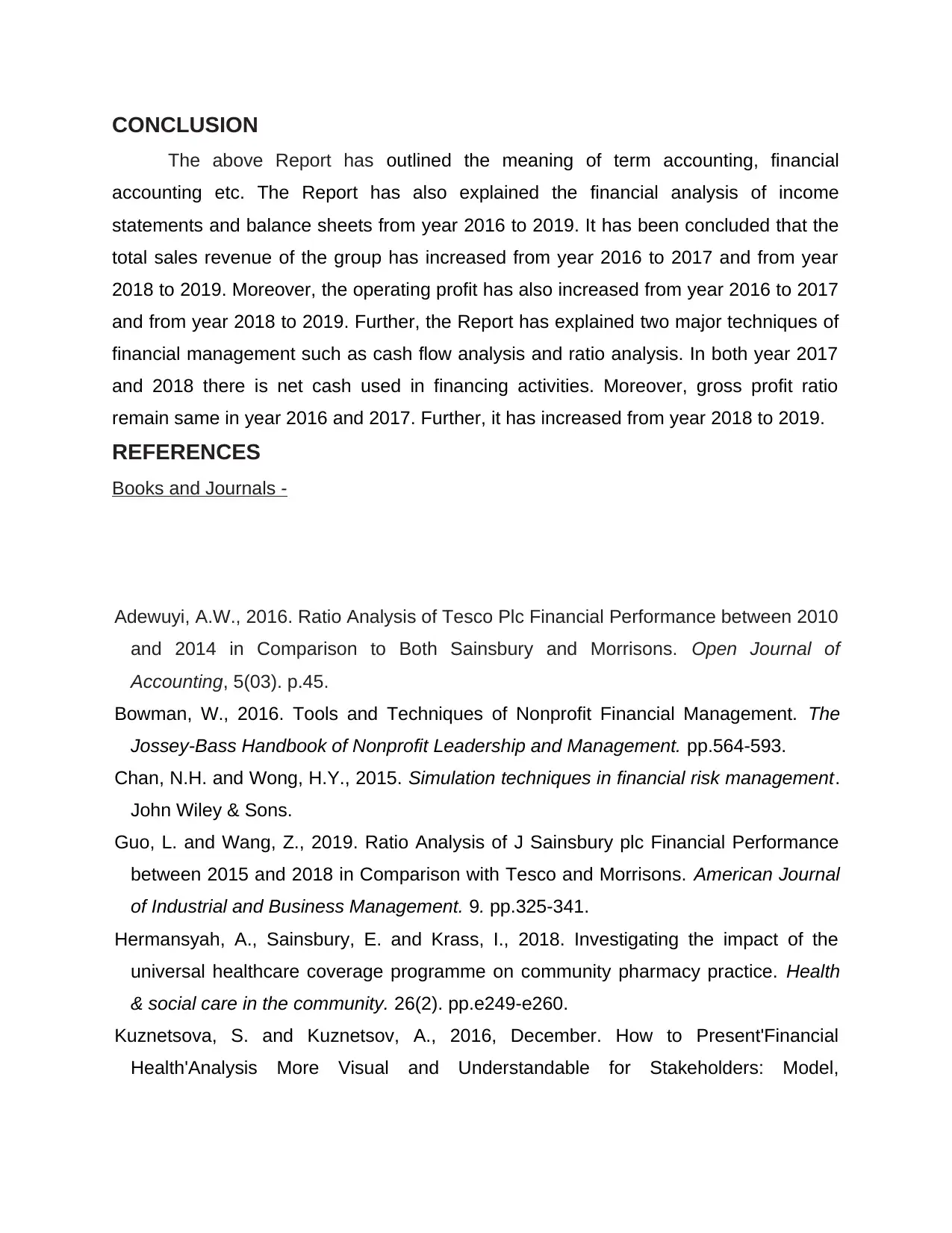
CONCLUSION
The above Report has outlined the meaning of term accounting, financial
accounting etc. The Report has also explained the financial analysis of income
statements and balance sheets from year 2016 to 2019. It has been concluded that the
total sales revenue of the group has increased from year 2016 to 2017 and from year
2018 to 2019. Moreover, the operating profit has also increased from year 2016 to 2017
and from year 2018 to 2019. Further, the Report has explained two major techniques of
financial management such as cash flow analysis and ratio analysis. In both year 2017
and 2018 there is net cash used in financing activities. Moreover, gross profit ratio
remain same in year 2016 and 2017. Further, it has increased from year 2018 to 2019.
REFERENCES
Books and Journals -
Adewuyi, A.W., 2016. Ratio Analysis of Tesco Plc Financial Performance between 2010
and 2014 in Comparison to Both Sainsbury and Morrisons. Open Journal of
Accounting, 5(03). p.45.
Bowman, W., 2016. Tools and Techniques of Nonprofit Financial Management. The
Jossey‐Bass Handbook of Nonprofit Leadership and Management. pp.564-593.
Chan, N.H. and Wong, H.Y., 2015. Simulation techniques in financial risk management.
John Wiley & Sons.
Guo, L. and Wang, Z., 2019. Ratio Analysis of J Sainsbury plc Financial Performance
between 2015 and 2018 in Comparison with Tesco and Morrisons. American Journal
of Industrial and Business Management. 9. pp.325-341.
Hermansyah, A., Sainsbury, E. and Krass, I., 2018. Investigating the impact of the
universal healthcare coverage programme on community pharmacy practice. Health
& social care in the community. 26(2). pp.e249-e260.
Kuznetsova, S. and Kuznetsov, A., 2016, December. How to Present'Financial
Health'Analysis More Visual and Understandable for Stakeholders: Model,
The above Report has outlined the meaning of term accounting, financial
accounting etc. The Report has also explained the financial analysis of income
statements and balance sheets from year 2016 to 2019. It has been concluded that the
total sales revenue of the group has increased from year 2016 to 2017 and from year
2018 to 2019. Moreover, the operating profit has also increased from year 2016 to 2017
and from year 2018 to 2019. Further, the Report has explained two major techniques of
financial management such as cash flow analysis and ratio analysis. In both year 2017
and 2018 there is net cash used in financing activities. Moreover, gross profit ratio
remain same in year 2016 and 2017. Further, it has increased from year 2018 to 2019.
REFERENCES
Books and Journals -
Adewuyi, A.W., 2016. Ratio Analysis of Tesco Plc Financial Performance between 2010
and 2014 in Comparison to Both Sainsbury and Morrisons. Open Journal of
Accounting, 5(03). p.45.
Bowman, W., 2016. Tools and Techniques of Nonprofit Financial Management. The
Jossey‐Bass Handbook of Nonprofit Leadership and Management. pp.564-593.
Chan, N.H. and Wong, H.Y., 2015. Simulation techniques in financial risk management.
John Wiley & Sons.
Guo, L. and Wang, Z., 2019. Ratio Analysis of J Sainsbury plc Financial Performance
between 2015 and 2018 in Comparison with Tesco and Morrisons. American Journal
of Industrial and Business Management. 9. pp.325-341.
Hermansyah, A., Sainsbury, E. and Krass, I., 2018. Investigating the impact of the
universal healthcare coverage programme on community pharmacy practice. Health
& social care in the community. 26(2). pp.e249-e260.
Kuznetsova, S. and Kuznetsov, A., 2016, December. How to Present'Financial
Health'Analysis More Visual and Understandable for Stakeholders: Model,
Secure Best Marks with AI Grader
Need help grading? Try our AI Grader for instant feedback on your assignments.
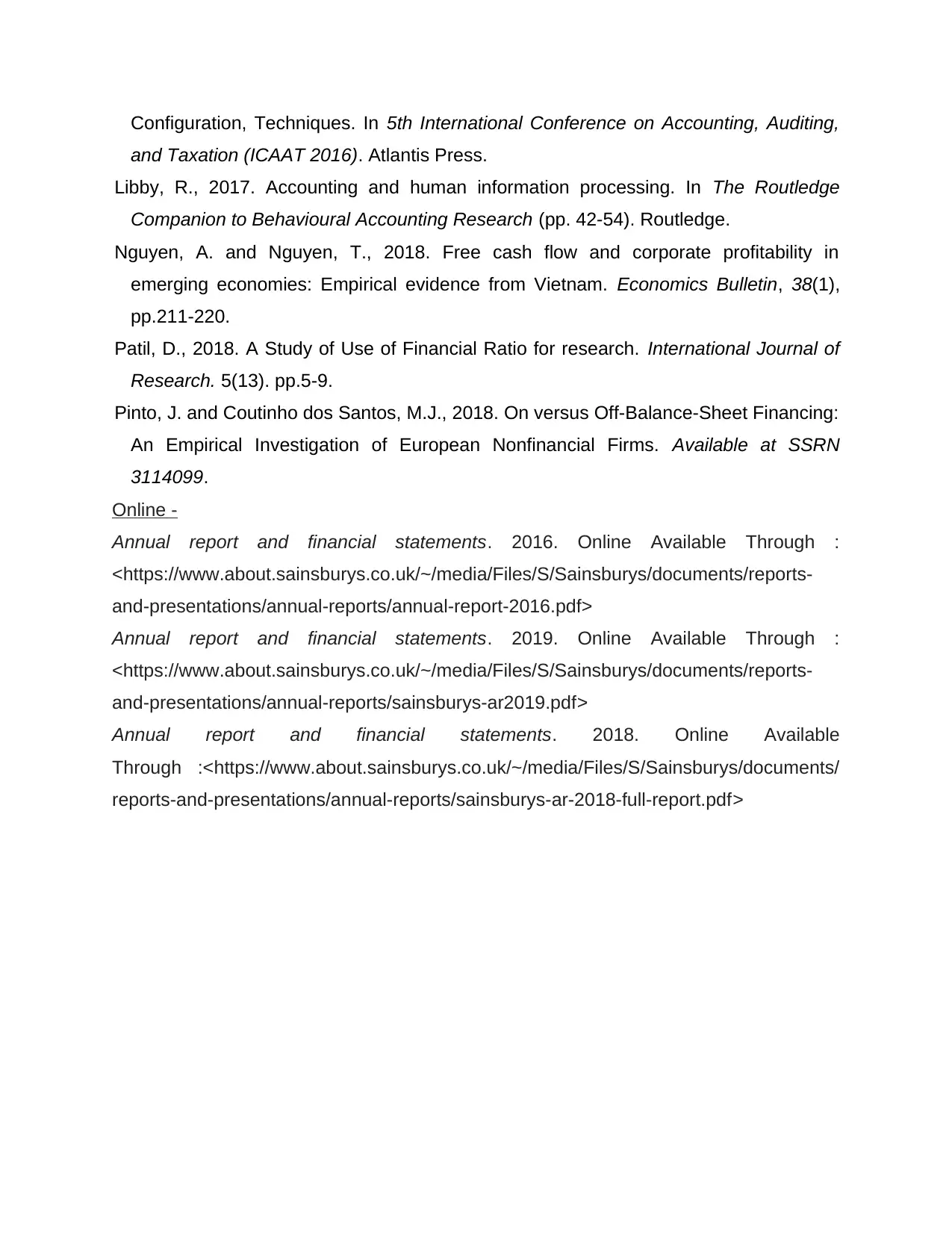
Configuration, Techniques. In 5th International Conference on Accounting, Auditing,
and Taxation (ICAAT 2016). Atlantis Press.
Libby, R., 2017. Accounting and human information processing. In The Routledge
Companion to Behavioural Accounting Research (pp. 42-54). Routledge.
Nguyen, A. and Nguyen, T., 2018. Free cash flow and corporate profitability in
emerging economies: Empirical evidence from Vietnam. Economics Bulletin, 38(1),
pp.211-220.
Patil, D., 2018. A Study of Use of Financial Ratio for research. International Journal of
Research. 5(13). pp.5-9.
Pinto, J. and Coutinho dos Santos, M.J., 2018. On versus Off-Balance-Sheet Financing:
An Empirical Investigation of European Nonfinancial Firms. Available at SSRN
3114099.
Online -
Annual report and financial statements. 2016. Online Available Through :
<https://www.about.sainsburys.co.uk/~/media/Files/S/Sainsburys/documents/reports-
and-presentations/annual-reports/annual-report-2016.pdf>
Annual report and financial statements. 2019. Online Available Through :
<https://www.about.sainsburys.co.uk/~/media/Files/S/Sainsburys/documents/reports-
and-presentations/annual-reports/sainsburys-ar2019.pdf>
Annual report and financial statements. 2018. Online Available
Through :<https://www.about.sainsburys.co.uk/~/media/Files/S/Sainsburys/documents/
reports-and-presentations/annual-reports/sainsburys-ar-2018-full-report.pdf>
and Taxation (ICAAT 2016). Atlantis Press.
Libby, R., 2017. Accounting and human information processing. In The Routledge
Companion to Behavioural Accounting Research (pp. 42-54). Routledge.
Nguyen, A. and Nguyen, T., 2018. Free cash flow and corporate profitability in
emerging economies: Empirical evidence from Vietnam. Economics Bulletin, 38(1),
pp.211-220.
Patil, D., 2018. A Study of Use of Financial Ratio for research. International Journal of
Research. 5(13). pp.5-9.
Pinto, J. and Coutinho dos Santos, M.J., 2018. On versus Off-Balance-Sheet Financing:
An Empirical Investigation of European Nonfinancial Firms. Available at SSRN
3114099.
Online -
Annual report and financial statements. 2016. Online Available Through :
<https://www.about.sainsburys.co.uk/~/media/Files/S/Sainsburys/documents/reports-
and-presentations/annual-reports/annual-report-2016.pdf>
Annual report and financial statements. 2019. Online Available Through :
<https://www.about.sainsburys.co.uk/~/media/Files/S/Sainsburys/documents/reports-
and-presentations/annual-reports/sainsburys-ar2019.pdf>
Annual report and financial statements. 2018. Online Available
Through :<https://www.about.sainsburys.co.uk/~/media/Files/S/Sainsburys/documents/
reports-and-presentations/annual-reports/sainsburys-ar-2018-full-report.pdf>

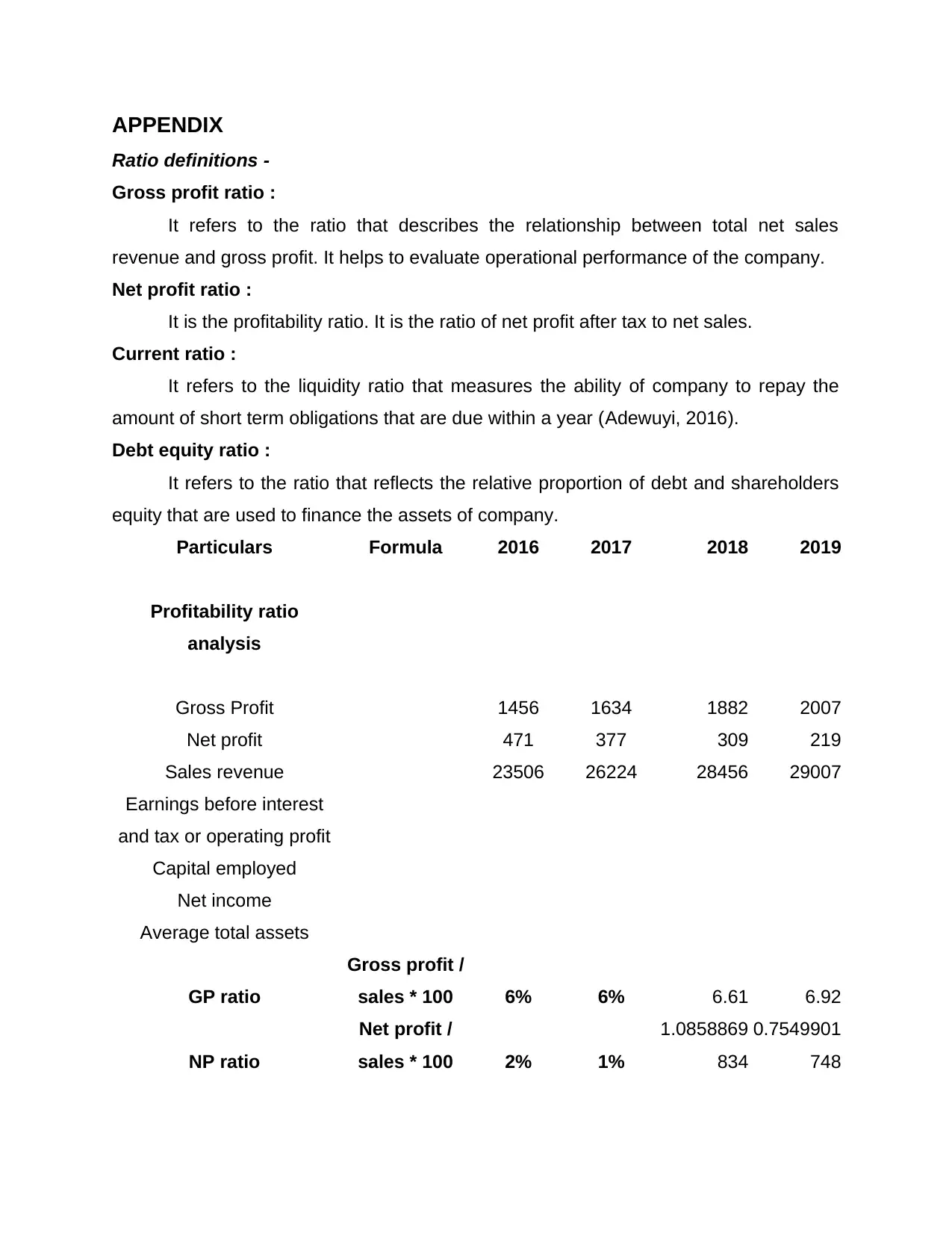
APPENDIX
Ratio definitions -
Gross profit ratio :
It refers to the ratio that describes the relationship between total net sales
revenue and gross profit. It helps to evaluate operational performance of the company.
Net profit ratio :
It is the profitability ratio. It is the ratio of net profit after tax to net sales.
Current ratio :
It refers to the liquidity ratio that measures the ability of company to repay the
amount of short term obligations that are due within a year (Adewuyi, 2016).
Debt equity ratio :
It refers to the ratio that reflects the relative proportion of debt and shareholders
equity that are used to finance the assets of company.
Particulars Formula 2016 2017 2018 2019
Profitability ratio
analysis
Gross Profit 1456 1634 1882 2007
Net profit 471 377 309 219
Sales revenue 23506 26224 28456 29007
Earnings before interest
and tax or operating profit
Capital employed
Net income
Average total assets
GP ratio
Gross profit /
sales * 100 6% 6% 6.61 6.92
NP ratio
Net profit /
sales * 100 2% 1%
1.0858869
834
0.7549901
748
Ratio definitions -
Gross profit ratio :
It refers to the ratio that describes the relationship between total net sales
revenue and gross profit. It helps to evaluate operational performance of the company.
Net profit ratio :
It is the profitability ratio. It is the ratio of net profit after tax to net sales.
Current ratio :
It refers to the liquidity ratio that measures the ability of company to repay the
amount of short term obligations that are due within a year (Adewuyi, 2016).
Debt equity ratio :
It refers to the ratio that reflects the relative proportion of debt and shareholders
equity that are used to finance the assets of company.
Particulars Formula 2016 2017 2018 2019
Profitability ratio
analysis
Gross Profit 1456 1634 1882 2007
Net profit 471 377 309 219
Sales revenue 23506 26224 28456 29007
Earnings before interest
and tax or operating profit
Capital employed
Net income
Average total assets
GP ratio
Gross profit /
sales * 100 6% 6% 6.61 6.92
NP ratio
Net profit /
sales * 100 2% 1%
1.0858869
834
0.7549901
748
Paraphrase This Document
Need a fresh take? Get an instant paraphrase of this document with our AI Paraphraser
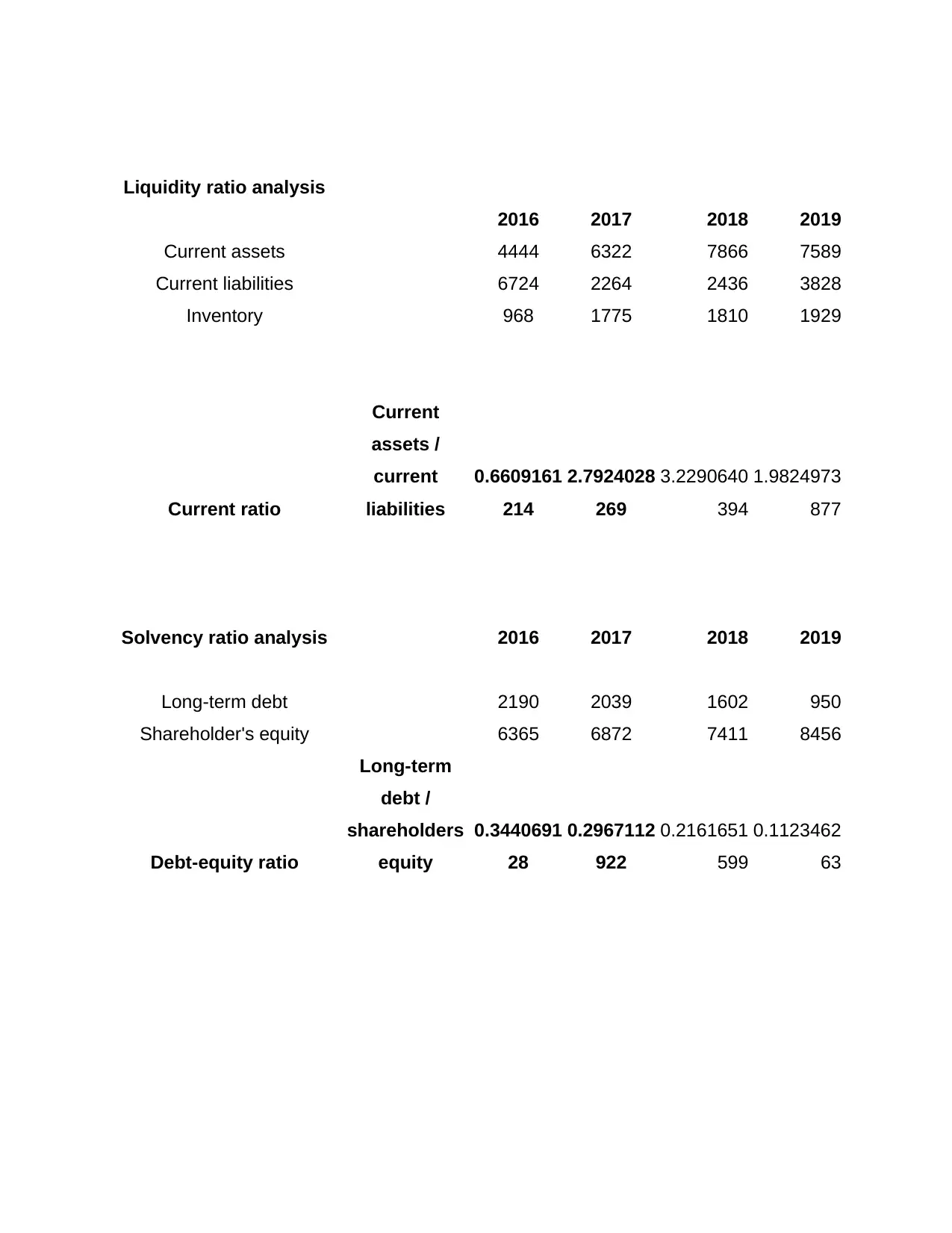
Liquidity ratio analysis
2016 2017 2018 2019
Current assets 4444 6322 7866 7589
Current liabilities 6724 2264 2436 3828
Inventory 968 1775 1810 1929
Current ratio
Current
assets /
current
liabilities
0.6609161
214
2.7924028
269
3.2290640
394
1.9824973
877
Solvency ratio analysis 2016 2017 2018 2019
Long-term debt 2190 2039 1602 950
Shareholder's equity 6365 6872 7411 8456
Debt-equity ratio
Long-term
debt /
shareholders
equity
0.3440691
28
0.2967112
922
0.2161651
599
0.1123462
63
2016 2017 2018 2019
Current assets 4444 6322 7866 7589
Current liabilities 6724 2264 2436 3828
Inventory 968 1775 1810 1929
Current ratio
Current
assets /
current
liabilities
0.6609161
214
2.7924028
269
3.2290640
394
1.9824973
877
Solvency ratio analysis 2016 2017 2018 2019
Long-term debt 2190 2039 1602 950
Shareholder's equity 6365 6872 7411 8456
Debt-equity ratio
Long-term
debt /
shareholders
equity
0.3440691
28
0.2967112
922
0.2161651
599
0.1123462
63

1 out of 15
Related Documents
Your All-in-One AI-Powered Toolkit for Academic Success.
+13062052269
info@desklib.com
Available 24*7 on WhatsApp / Email
![[object Object]](/_next/static/media/star-bottom.7253800d.svg)
Unlock your academic potential
© 2024 | Zucol Services PVT LTD | All rights reserved.



